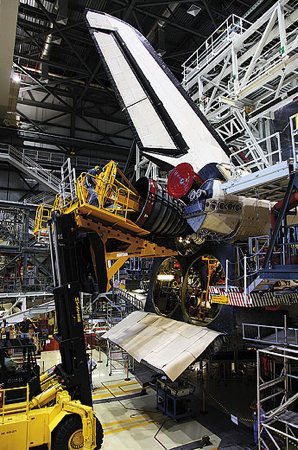
Before the space shuttles Atlantis, Discovery, and Endeavour are placed in their final interment at museums, NASA scientists are dissecting them to remove any hazardous materials and evaluate how the various components held up over years of use. Air & Space Magazine's Greg Freiherr observed some of the autopsies. I'd like to see an iFixit Teardown of one of these orbiters. From Air & Space:
Orbit Autopsies
Orbiter Processing Facility 2 is all about warnings. The blue metal door leading inside bears two against unauthorized entry, a third about electrical hazards, and a caution against unfastened objects.
Once inside today, the orbiter processing team will remove one of Endeavour’s two orbital maneuvering system pods, which bookend the vertical stabilizer. As the drone of ventilators fills the building, a technician wearing a “Lucky’s Bar” T-shirt thumbs a manual detailing the steps for excising the orbital maneuvering systems. Held by a latticework of steel beams, the pod rotates out and into the free-hang position, ready for the next day’s crew to winch it into retirement.
Long gone are Endeavour’s main engines. Technicians have plucked them with what looks like a Space Age version of a medieval battering ram. Mounted on a 20-foot-high forklift, the steel probe, its tip sheathed in black padding, had pressed into the nozzle of each engine. It extracted them one at a time, hauling them away for storage in a NASA facility at White Sands, New Mexico.


No comments:
Post a Comment